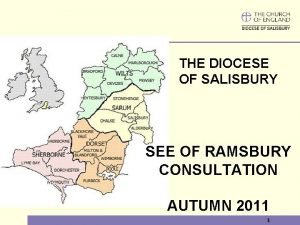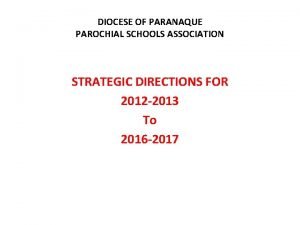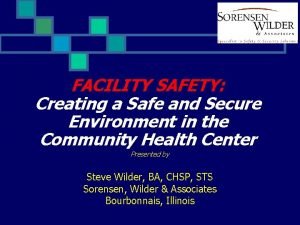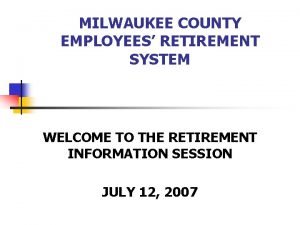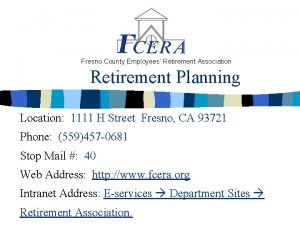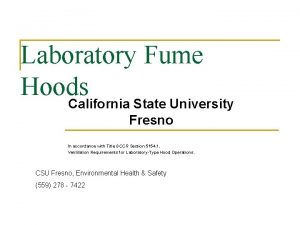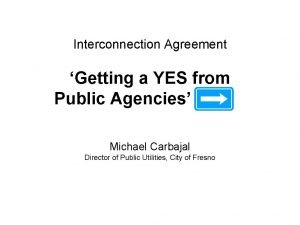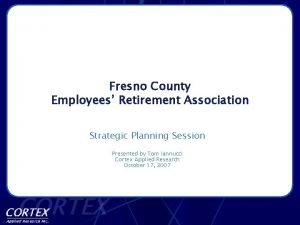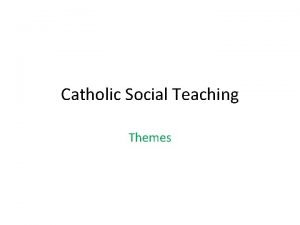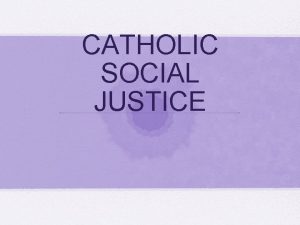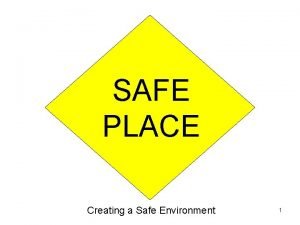Roman Catholic Diocese of Fresno Safe Environment To
































- Slides: 32

Roman Catholic Diocese of Fresno “Safe Environment” To create a safe environment for children is of paramount importance for the Church, and everyone in the Church is responsible for ensuring that this exists. No one can say, “It’s not my job. ”

An Overview of The Charter for the Protection of Children and Young People To promote healing and reconciliation with victims/ survivors of sexual abuse of minors within the Church. To ensure an effective response to allegations of sexual abuse of minors within the Church and to well-publicized standards of ministerial behavior and appropriate boundaries of clergy and any other church personnel or volunteer in positions of trust who have regular contact with children and young people. Establishes procedures to ensure accountability, and to provide safe environments programs for all God’s people through screening, training and ongoing education of all ministers – ordained and laity. To provide educational opportunities and resources for parents, children and youth.

The Roman Catholic Diocese of Fresno SAFE ENVIRONMENT REQUIREMENTS CLERGY: All visiting clergy must present a Letter of Suitability to the Office of the Bishop in order to receive Faculties, regardless of their length of stay. This must be received well in advance of their expected visit. Clergy may not stay overnight at a private residence other than the home of a relative. Visiting clergy are expected to stay at the rectory; if not, the hosting parish is to make other appropriate accommodations. STEP ONE: EMPLOYMENT AND VOLUNTEER APPLICATIONS An Employment or Volunteer Application should be completed and kept on File. All professional and personal references should be contacted prior to employment. STEP TWO: BACKGROUND CHECK Employees and all volunteers who have contact with minors in the course of their duties must be fingerprint cleared. Direct constant supervision must be provided by an adult who meets all Safe Environment requirements until verification of clearance is received.

STEP THREE: SAFE ENVIRONMENT TRAINING ALL employees must sign the Diocesan Code of Conduct PRIOR to the start of employment and if they will have contact with minors they must complete Safe Environment Training as soon as possible or within the first 60 days of the start of employment. ALL volunteers who will have contact with minors must sign the Diocesan Code of Conduct PRIOR to beginning volunteer service. Training is to be completed before volunteer service begins. All continuing employees and volunteers must attend all renewal training sessions provided by the Diocese on a three-year cycle. STEP FOUR: SAFE ENVIRONMENT FOR CHILDREN/YOUTH AND PARENTS K-12 Catholic Safe Environment Curriculum is to be integrated into all religious education programs. It includes K-12 Lesson Plans and a Parent Training. The program is available in English and Spanish. If a parent does NOT want their child to participate in the program, the parent must fill out an “opt-out form” with the parish staff prior to the presentation and the parent must ensure that the child does NOT attend the presentation.

APPROPRIATE SUPERVISON OF CHILDREN ON AND OFF SITE When there is a parish or diocesan event where children are present, certain precaution must be observed in order to assure the children’s safety. The Safe Environment and Risk Management Offices work to support parishes and schools in this regard and are available for consultation as needed. • When children are accompanied by their parents, the parents are responsible of their safety. • When children are on the same property but in a different location than their parents, someone assigned by the organization must take the responsibility of supervising the children. Such person(s) must meet all Safe Environment requirements.

TEN POINTS TO CREATING A SAFE ENVIRONMENT FOR CHILDREN 1. 2. 3. 4. 5. 6. 7. 8. 9. Sexual molestation is about the victim. No one has the right to have access to children. Common sense is not all that common. Child sexual abuse can be prevented. The residual effects of having been abused can last a lifetime. Feeling heard leads toward healing. You cannot always predict who will be an abuser. There are behavioral warning signs of child abusers. People can be taught to identify grooming behavior. 10. Background checks work.

WHO are Potential Victims? Boys and Girls are equally likely to be abused, but boys account for over 57% of all fatalities. 1 in 10 children suffer from child maltreatment. 1 in 16 children are victims of sexual abuse (girls are 1 in 5, and boys are 1 in 20) Nearly 1 in 10 children are witnesses of family violence. The youngest of children are most vulnerable to maltreatment. Over 25% of abused children are under the age of three while over 45% of abused children are under the age of five. The United States loses 7 children to death each day due to Abuse or Neglect

Neglect is overwhelming the most common form of child maltreatment (79. 5%) 18% are victims of physical abuse 9% are victims of sexual abuse 9 % are victims of psychological abuse 2. 3 % are victims of medical neglect 10 % of all cases are due to “other” maltreatment, such as threatened abuse, or affected by parent(s) substance abuse In 2013, 87% of all victims of abuse compromised the following race or ethnicities: White (44%) African-American (21%) Hispanic (22%)

What puts a child at Risk for Maltreatment? o 14% of victims are from families experiencing financial problems o 30% of victims are from families receiving public assistance o 27% of victims are exposed to domestic violence o 12. 6% of victims had some form of disability Sources: 1. National Child Abuse and Neglect Data System. Child Maltreatment 2012. Accessed January 2014. http: //www. acf. hhs. gov/programs/cb/resource/child-maltreatment-2012 2. U. S. Dept of Health and Human Services. Fourth National Incidence Study of Child Abuse and Neglect. Report to Congress. www. acf. hhs. gov/programs/opre/abuse_neglect/natl_incid/index. html Accessed January 2010. 3. Child Welfare Information Gateway. Child Maltreatment 2013: Summary of Key Findings. http: //www. shildwelfare. gov

What does the abuser look like? o In 2012, in 80% of all cases, the parent was the perpetrator o In 2012, 82% of perpetrators were between the ages of 18 and 44 years, while 40% were in the 25 -34 age group. o In 2012, 45% of the perpetrators were male and 54% were female Long Term affects of childhood maltreatment o 80% of adults meet criteria for at least one psychiatric disorder by the age of 21 (depression, suicide attempts, eating disorders). o 65% of those in drug treatment programs reported being abused as children o 1/3 rd will abuse their own children

WHAT is Child Abuse? California State law defines child abuse as (1) physical injury inflicted on a child by another person, (2) sexual abuse, or (3) emotional abuse. Child neglect is defined as negligent treatment which threatens the child's health or welfare. The different types of child abuse/neglect can be categorized as: • • Sexual abuse is the victimization of a child by sexual activities, including molestation, indecent exposure, fondling, rape, and incest. Physical abuse is a bodily injury inflicted by other than accidental means on a child, including willful cruelty, unjustifiable punishment, or corporal punishment.

Emotional abuse is nonphysical mistreatment, resulting in disturbed behavior by the child, such as severe withdrawal or hyperactivity. Emotional abuse includes willfully causing any child to suffer, inflicting mental suffering, or endangering a child's emotional well-being. • General neglect is the negligent failure of a parent/guardian or caretaker to provide adequate food, clothing, shelter, or supervision where no physical injury to the child has occurred. • Severe neglect refers to those situations of neglect where the child's health is endangered, including severe malnutrition. • Exploitation means forcing or coercing a child into performing activities that are beyond the child's • capabilities or which are illegal or degrading, • including sexual exploitation. •

Physical Abuse Physical abuse is a non-accidental physical injury (ranging from minor bruises and broken bones to death) caused by punching, beating, kicking, shaking, throwing, biting, burning, stabbing, choking (with a hand or other object) that is inflicted by a parent, caregiver or other adult. Child abuse does not include spanking by a parent or legal guardian that is reasonable and age appropriate and does not cause bodily injury to the child. If the abuse occurs by someone who lives in the same household as the child, the local CPS agency receives the report; if not, then the report is made to local law enforcement.

Neglect is failure of a parent, guardian or other caregiver to provide for a child’s basic needs. This includes adequate food, clothing, shelter, appropriate supervision, medical treatment, educational needs, inattention to emotional and psychological needs, or allowing a child to use alcohol or other drugs. If neglect is suspected, the report is made to the local CPS agency.

Sexual Abuse: Sexual abuse is any sexual behavior with a child including physical acts such as touching the child’s private areas of the body and/or having the child touch the adult or a third party in a sexual manner, intercourse, indecent exposure, production of or viewing of pornography, and any form of sexual exploitation by word or deed. Sexual abuse of a minor is always reported to Law Enforcement.

Emotional Abuse: Emotional abuse is behavior that affects a child’s emotional development or sense of self-worth. This pattern of behavior can include constant belittling, criticism, threats, rejection, name calling, habitual blaming or using derogatory terms to describe the child. This can also include isolating the child from normal social encounters with their peers, confining or limiting the child’s movement, withholding love and affection, support or guidance, and teaching or encouraging the child to develop inappropriate behaviors or activities. If a child/youth reports they are the victim of emotional abuse by someone who lives in the home, it is reported to your local CPS agency

WHEN do Predators appear? Predators will groom an entire community, adults and children. Predators will intentionally get a job with regular, unsuspecting access to minors or vulnerable adults as part of their role, daily “job description”, and work duties. Charming and use of positive associations: gifts, money, “rescuing”, treats, affection/“love, ” humor, favors. Testing boundaries of parents and minors in order to gain trust, normalize touch, and access. Predators isolate their prey. Predators will take advantage of any situation to offend. Predators will look for opportunities to offend. Predators will target vulnerable victims first.

Bullying Refers to the repeated aggressive behavior committed by an individual regardless of age to intentionally cause physical or mental harm to another. Bullying can include: physical violence, threats and intimidation, name calling and belittling, spreading rumors or gossiping maliciously, public humiliation, and social exclusions. Victims of bullying: • Have a higher risk of depression and anxiety • Have changes in sleep or eating patterns • Lose interest in activities • Have decreased academic performance and are more likely to skip, miss or drop out of school. • More likely to retaliate by violent and extreme means.

Warning signs if a child is being bullied: • Is afraid to go to school or be involved in other • • • activities with their peers. Over 160, 000 students miss school daily for fear of bullying behavior. Feels sad, moody, anxious, or depressed when they come home from school or an activity with their peers. Expresses feelings of helplessness. Avoids certain places. Changes in behavior, out of the usual. Expresses feelings of not being good enough. Change in eating habits Unexplained injuries or hurts themselves. Sudden changes in friendships. Change in sleeping patterns, possible nightmares.

Warning signs if a child is a bully: • • Acts violently toward others, either verbally or physically. Gets sent to the Principal’s Office frequently. Has extra money or belongings that cannot be explained. Does not take responsibility for their actions. Has friends who are bullies. Has difficulty feeling empathy or compassion for others. Blames other for their actions or behaviors. (Training Handbook Pg. 12 -13)

Internet Safety and Cyber-Bullying The internet has changed the way we experience and interact with each other and with the world. In spite of the many benefits the Internet offers, it also has numerous hazards that can affect a child’s innocence as well as pose dangers to the emotional, spiritual and psychological well-being of youth and adults alike. The Children’s Online Privacy Protection Act, a federal law passed in 2000 was created to protect children online. A child’s best defense against online predators or becoming a victim of bullying is a parent or caregiver who monitors the use of the computer by a child and talking and educating them about the dangers and risks that are online.

Cyber-Bullying and Texting This type of bullying behavior occurs most often through the use of technology such as computers, cell phones and other electronic devices and not face-to-face. Cyber-bullying is more likely to occur in the late middle school years through high school; 93% of teens from 12 -17 years are online at any given time within a 24 hour period. 42% of teens report of having been bullied while online.

Sexting is sending sexually explicit texts or photographs via any form of electronic technology, e. g. cell phones, i. Pads, computers. Sexting can have serious legal implications and consequences based on a variety of state and federal laws. Four different California legislations are currently pending to enact penalties for Sexting between minors.

Suggestion on How to Keep Safe: • • Never post or send sexually explicit pictures. Mutual respect is the basis of healthy relationships. Refuse to send explicit pictures. If threatened to do so, talk to a trusted adult. Never open or forward an explicit picture received from someone you do not know. Remember an online friend that you have not met or don’t know is really a “stranger. ” If someone sends you explicit pictures repeatedly, talk to trusted adult. Law enforcement may have to get involved. Be a good friend and discourage friends from sexting behavior. Keep each other safe!

WHY do we Train? 1. Training adults to recognize a child in crisis can save lives. 2. Training children to recognize risky situations can save lives. 3. Training employees/volunteers and parents to be aware of the risks and dangers that a youth/teen may face; and reinforcing how to respond to any situation of “unsafe” conduct or situations, and teaching a youth/teen or teen about personal safety can help prevent harm to a child. All are responsible to make the appropriate report of any suspected child abuse maltreatment.

Child Abuse and Neglect Hotline • In cases of an immediate emergency always call 911 for Law Enforcement intervention. Where the situation is not an emergency needing the police, reports should be made via phone immediately to the Child Abuse and Neglect Hotline for your county. Complete the SCAR form online: http: //ag. ca. gov/childabuse/pdf/ss_8572. pdf The commentary should accurately reflect what the child revealed to you! Note who you spoke to at CPS or Law Enforcement, name and phone number. Print, sign the report, keep a copy and fax the form within 36 hours to your county agency.

Mandated Reporters: any adult person in a paid position that places them in regular contact with minors in a supervisory capacity. Ethical reporters An unpaid person (volunteer) or any community individual who is witness to abuse taking place, places the report to CPS with the assistance of a mandated reporter. Any volunteer position that place an adult in regular contact with minors in a supervisory capacity is an ethical reporter. Report any suspicion of child endangerment to an available supervisor who is a Mandated Reporter, Child Welfare Services and/or Law Enforcement immediately.

Summary: DO NOT assume your supervisor will submit a report. DO NOT assume you don’t need to submit a “ 2 nd” report if somebody (parent, child, etc) states that someone has already done so. --------------------Report if you SUSPECT or receive direct report in regards to: HARM HARM to to to Self (specific/identifiable) Others Elderly Children/Minors under 18 a Dependent (Vulnerable) Adult

How Do Victims Tell? Direct disclosure / very uncommon Indirect disclosure • Victim may believe they told an adult but information is vague/indirect that the adult does not understand it to be a report of any kind of abuse. Disclosure with strings attached “Can you keep a secret? ” “Promise you won’t tell” Disguised or Third Person disclosure What if something like this happened to friend of mine? ” Accidental disclosure; not consciously done, not prepared emotionally to tell.

What to Do when a Victim Tells? • Give the child/teen VALIDATION without any INVESTIGATION “I am so sorry to hear that, let’s talk about it before you leave today. ” • Use a TEAM approach and LISTEN to the report. Do not ask a lot of questions, this can hinder an investigation. “Tell me what is going on. ” (Give physical, not verbal, gestures of listening, such as eye contact, head movement, etc) • DO NOT make any PROMISES. We cannot solve this problem alone. “Wow, this must be tough, let’s call my someone (CPS) and get some advice. ” • AVOID parental/guardian confrontation.

• Call the police (911) if the child outright refuses to go home. • Call the police (911) if a parent/guardian is intoxicated at pick up time. • Call the police (911) if you witness or see a weapon of any kind. • Call the police (911) if you or the child is threatened. • Call the police (911) if you are in doubt. Report this to your supervisor and CPS or local Law Enforcement IMMEDIATELY.

Have Questions? Need Advice? Unsure to Report or not? Need more Training? Need Help Submitting a Report? CALL or EMAIL: Safe Environment Office, Diocese of Fresno 559 -493 -2882
 Roman catholic diocese of syracuse
Roman catholic diocese of syracuse Chester diocese re planning
Chester diocese re planning Diocese of coventry mat
Diocese of coventry mat Diocese de lorena
Diocese de lorena Diocese of salisbury
Diocese of salisbury Southern diocese curriculum
Southern diocese curriculum Anglican diocese of new england
Anglican diocese of new england Diocese of the midwest
Diocese of the midwest Plymouth diocese
Plymouth diocese Diocese of paranaque
Diocese of paranaque Safe feed safe food
Safe feed safe food Safe people safe places
Safe people safe places Social contract orientation
Social contract orientation Beliefs of roman catholic
Beliefs of roman catholic Hierarchy catholic church
Hierarchy catholic church Symbolism
Symbolism Protestant
Protestant What is roman catholic beliefs
What is roman catholic beliefs Medieval church hierarchy pyramid
Medieval church hierarchy pyramid Difference between protestant and catholic
Difference between protestant and catholic Roman catholic vs eastern orthodox
Roman catholic vs eastern orthodox Safe and secure environment
Safe and secure environment Financial environment in business environment
Financial environment in business environment Roman republic vs roman empire
Roman republic vs roman empire Empire
Empire Fresno asset allocation
Fresno asset allocation Smartfind express fresno
Smartfind express fresno Milwaukee county intranet
Milwaukee county intranet Fresno county retirement
Fresno county retirement Fresno state personal statement
Fresno state personal statement Fresno hoods
Fresno hoods Michael carbajal fresno
Michael carbajal fresno Fcera fresno
Fcera fresno




